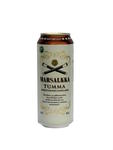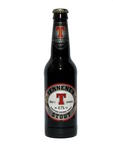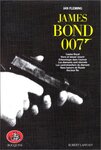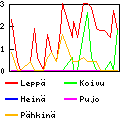Probabilities
Traduction: [ Google | Babelfish ]
Catégories : [ Science ]
Before Easter, the supermarket was selling Rölli suprise-eggs, announcing that every fifth egg contained a figurine related to Rölli's universe. This made me wonder: how many eggs you need to buy to ensure that you get at least one such figurine?
The following formula gives the probability (p) of getting at least one Rölli figurine given that one has bought n eggs, and that every k egg contains such a figurine:
p = 1 − (1 − 1/k)n
The answer to the first question is not straightforward, though. To be absolutely sure to get at least one figurine, you need to buy 4/5 of the egg production plus one egg, because there is always an (admitedly slim) chance that the 4/5 of are made entirely of eggs containing something else than a Rölli figurine, and that the 1/5 that is left is made only of eggs containing Rölli figurines. The extra egg that you need to buy is therefore taken from this last 1/5, and is guaranteed to contain a Rölli figurine.
If you are not willing to spend so much time and money tracking and buying most of the egg production, you can trade time and money for a tiny bit of uncertainty. For example, if you can accept to have only 90% chance of getting a Rölli figurine instead of 100%, it is enough to buy 11 eggs. If you want a better chance yet and want to go for 95%, you need to buy 14 eggs. Finally, if you want a 99% chance, you need to get 21 eggs. These values were computed from the formula above, setting k = 5 (“every fifth egg”), p = 0.90 or p = 0.95 or p = 0.99, solving the equation for n and rounding the result to the nearest, larger integer.
It is also worth noticing that if you decide to buy 5 eggs (because every 5th egg contains a Rölli figurine), you have only about 2 in 3 chances of getting a Rölli figurine.
The table below gives the minimum values of n for a given value of k and different probability thresholds. It also gives the ratio n over k, i.e., given a “one in k” probability, how many times k does one need to get to have a probability greater than the thresold. The second column also indicates, given a “one in k” probability, what are you chances of getting what you want if you get k items. Notice that these values grow toward a given, finite limit when k grows larger.
| k | p(n=k) | p≥0.90 (n/k) | p≥0.95 (n/k) | p≥0.99 (n/k) |
|---|---|---|---|---|
| 2 | 0.750 | 4 (2.000) | 5 (2.500) | 7 (3.500) |
| 3 | 0.704 | 6 (2.000) | 8 (2.667) | 12 (4.000) |
| 4 | 0.684 | 9 (2.250) | 11 (2.750) | 17 (4.250) |
| 5 | 0.672 | 11 (2.200) | 14 (2.800) | 21 (4.200) |
| 6 | 0.665 | 13 (2.167) | 17 (2.833) | 26 (4.333) |
| 7 | 0.660 | 15 (2.143) | 20 (2.857) | 30 (4.286) |
| 8 | 0.656 | 18 (2.250) | 23 (2.875) | 35 (4.375) |
| 9 | 0.654 | 20 (2.222) | 26 (2.889) | 40 (4.444) |
| 10 | 0.651 | 22 (2.200) | 29 (2.900) | 44 (4.400) |
| 20 | 0.642 | 45 (2.250) | 59 (2.950) | 90 (4.500) |
| 37 | 0.637 | 85 (2.297) | 110 (2.973) | 169 (4.568) |
| 50 | 0.636 | 114 (2.280) | 149 (2.980) | 228 (4.560) |
| 100 | 0.634 | 230 (2.300) | 299 (2.990) | 459 (4.590) |
| 500 | 0.632 | 1151 (2.302) | 1497 (2.994) | 2301 (4.602) |
| 1000 | 0.632 | 2302 (2.302) | 2995 (2.995) | 4603 (4.603) |
One can use this table to find out how many times one needs to play the roulette in a casino to have 95% chance of winning at least once: a european roulette has 37 numbers (k = 37), and the limit of the n/k ratio is about 3; one therefore needs to play about n ≅ 37 × 3 = 111 times (the row for k = 37 indicates the actual value is n = 110).
[ Posté le 26 avril 2014 à 15:40 | pas de commentaire | lien permanent ]








